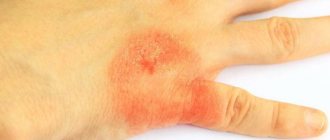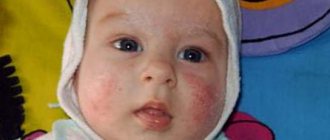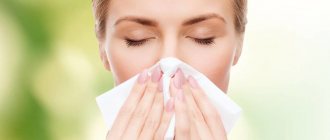Every year the number of people suffering from allergic diseases is increasing. There are many reasons that explain this trend: deterioration of the environmental situation; abundance of synthetic compounds in food, clothing, cosmetics; some concomitant diseases, etc.
It is believed that allergic reactions most often occur when eating certain types of food (food allergy) and during the seasonal flowering of certain plant species (seasonal hay fever). But few people think that sometimes there is an increased sensitivity of the body, for example, to smoking products. Let's consider whether there can be an allergy to cigarettes and, if so, how to recognize it.
- 7.1 Conclusion
Allergic reaction to tobacco smoke in children
Cigarette smoke has a negative impact on children's bodies. Therefore, smoking is prohibited in the room where an infant is located, because symptoms at this age manifest themselves quite intensely. Children over 3 years of age with intolerance to cigarette smoke develop the following symptoms:
- swelling of the mucous membrane;
- productive cough;
- severe headaches;
- peeling of the skin.
If any of these symptoms are detected, you should consult a pediatrician.
Symptoms
Many allergy symptoms in smokers can easily be confused with symptoms of common irritation of the mucous membranes of the eyes, nose, bronchi and lungs. Exposure to the caustic components of smog may cause watery eyes, eye irritation, a sore or sore throat, sneezing or coughing.
We can more definitely talk about an allergy from smoking if the smoker complains of symptoms of bronchial asthma:
- Difficulty breathing when exhaling.
- Severe shortness of breath.
- Anxiety.
- Pallor and blueness of lips, etc.
You can also suspect an allergy from smoking if you have symptoms of skin damage on your hands: the appearance of a rash like hives, eczema, scratching. The only problem is that these manifestations can appear in completely unexpected areas of the body. In this case, it is quite difficult to suspect the habit of smoking cigarettes as the cause of the allergy.
In addition, those who are accustomed to smoking may suddenly develop Quincke's edema, in which the following symptoms are observed:
- Sharp swelling of the face, larynx and trachea.
- A feeling of swelling of the affected tissues, burning and pain in them.
- Shortness of breath, barking cough.
- Allergic edema caused by smoking leads to difficulty breathing, up to the inability to take a breath.
An allergy that develops in response to smoking can also manifest itself as another extremely dangerous condition - anaphylactic shock, which requires emergency treatment. It is characterized by symptoms such as:
- Sudden loss of consciousness.
- A sharp decrease in blood pressure.
- Pallor and coldness of the skin.
- Cold sticky sweat.
- Cardiopalmus.
- Difficulty breathing.
In general, for cigarette smokers, allergies always manifest themselves individually. It can begin immediately with acute conditions requiring emergency treatment, such as Quincke's edema or anaphylactic shock, or it can develop gradually. The length of smoking before developing allergies also varies from person to person.
Symptoms of cigarette smoke intolerance
For the first time, an allergy to tobacco smoke may appear in the form of an increase in temperature. But often this pathology is characterized by the appearance of signs characteristic of inflammatory pathologies in the upper respiratory system, in the nasopharynx, accompanied by an asthmatic component. Patients with allergies or people with a genetic predisposition to such diseases are more susceptible to this condition.
Most often, an allergic reaction to tobacco products manifests itself in the form of:
- constant rhinitis, worsening in the morning;
- nasal congestion;
- frequent causeless bronchitis;
- paroxysmal suffocation;
- chronic inflammatory process in the nasopharynx, vocal cords, trachea, manifested by soreness, itching, hoarseness;
- lacrimation, cough syndrome.
It is worth noting that smoking contributes to the suppression of the immune system. Allergic symptoms initially appear pronounced, but weaken over time, which creates a false sense of well-being.
Types of therapy
It is impossible to completely treat an allergy to tobacco smoke without quitting smoking. If a person continues to smoke, tobacco allergens continue to enter the body. And his body continues to synthesize antibodies. However, to relieve allergy symptoms in those who smoke, the following types of treatment are usually carried out:
- Symptomatic.
- Anti-inflammatory.
- Immunomodulatory.
- General strengthening.
Symptomatic treatment is carried out with antihistamines. For this, various drugs are used that block specific receptors responsible for the release of histamine (Trexil, Gismanal, Claritin, Kestin, Zyrtec, Semprex).
Anti-inflammatory treatment is carried out to increase the effectiveness of antihistamines and relieve pain. To strengthen the immune system, various immunomodulatory drugs are used. For this purpose, general strengthening agents (vitamins, herbs, etc.) are also used.
Thus, if a smoker has an allergy, he urgently needs to give up cigarettes, because smoking and allergies are bad partners. After all, smoking can cause not only mild allergic conditions, but also lead to such serious consequences as bronchial asthma, Quincke's edema or anaphylactic shock. On the other hand, it is difficult to imagine that an allergy would develop in someone who quit smoking. A person who quits or quits smoking immediately notices relief from allergy symptoms, and treatment often leads to significant relief, and sometimes to complete recovery from allergies.
papirosamnet.ru
What is the danger of smoking if you have allergies?
Of course, it would be strange to hear a positive answer from a doctor to the question: “Is smoking allowed for asthma or any other disease?” But sometimes, in very difficult situations, it is necessary to give up cigarettes gradually. In this case, the dosage is gradually reduced until the supply of toxic substances to the body completely stops. However, a person still smokes for some time.
If allergies or bronchial asthma are diagnosed, this method will not work! If a reaction occurs to any components of tobacco, in order to get rid of the problem, you need to completely eliminate their supply to the body. Most often, experts recommend that such patients immediately and completely give up cigarettes.
Can smoking cause allergies?
The protective mechanisms of the immune system to an irritating factor in the form of an allergen are an allergic reaction. Almost any chemical substance can cause rejection in the body in the form of rashes. Smoking allergies are common
Can you be allergic to smoking?
Many people are interested in the question: can there be an allergy to nicotine?
The fact is that cigarette smoke is one of the most powerful allergens, which is explained by the large number of chemical elements included in the composition. The main components should be considered nicotine and tobacco, which may not be individually tolerated by the smoker. It is worth noting that scientists divide this body reaction into two types:
- The congenital type is observed in people from birth whose mothers smoked during pregnancy. This contributed to the accumulation of toxins in the body, which is why a person becomes highly sensitive to tobacco products.
- The acquired type appears during life after the accumulation of a certain substance in the body, which leads to its rejection by the immune system. In the case of smoking, it can manifest itself even with a long history of using tobacco products.
-Statistics-
According to statistics, almost a quarter of our country’s population, including children, suffer from smoking allergies
.
Each person experiences symptoms differently. It all depends on the individual degree of sensitivity to tobacco smoke or cigarettes. The most characteristic signs of an allergy from nicotine
are:
- runny nose;
- tearfulness;
- itching all over the body;
- the appearance of local redness;
- difficulty breathing;
- weakness;
- drowsiness;
- slight cough.
Usually, symptoms appear instantly, so it is not difficult to identify the cause of poor health.
-Advice-
You can find out the true allergen by consulting an allergist. Usually, special tests are prescribed to confirm the occurrence of a reaction to a specific product.
Consequences
The main consequences of allergies caused by smoking are:
include the development of chronic diseases such as dermatitis and asthma. Dermatitis manifests itself in the form of local redness and peeling.
The skin does not heal for a long time, remains painful and sensitive to touch. It is worth noting that asthma mainly appears in people exposed to passive smoking.
When inhaling the smell of a cigarette, a person becomes dizzy and begins to choke. More short-term consequences include:
- Atopic bronchitis is characterized by two periods of activation and decline. During the first, a person experiences severe coughing attacks, as well as a lack of oxygen.
- Quincke's edema often occurs when a smoker is allergic to smoking.
Swelling occurs due to the entry of a large number of allergens into the body. It is necessary to provide first aid to the person, since the patient’s condition is extremely unstable.
-Warning-
The chronic form of the disease is difficult to treat, so it is necessary to deal with the problem in a timely manner.
Treatment and prevention
It is recommended to completely avoid cigarettes if you have allergies.
if a person smokes. If a person is a passive smoker, then care must be taken to minimize interaction and contact with tobacco smoke.
If a reaction occurs, you must take medicine to relieve the symptoms. These include:
- Loratodine;
- Diazolin;
- Cetrilev.
-Advice-
It is better to select a medicine after consulting a doctor. The dosage is prescribed individually.
Allergy to nicotine in children
According to statistics, many children of smokers
are susceptible to tobacco products. It should be borne in mind that the reaction in children is quite acute. They immediately begin to experience severe coughing attacks, which arise due to the violation of the epithelial layer by smoke.
The inflammatory focus is located in the bronchi and lungs. Interestingly, allergies to nicotine occur in newborns.
This is possible if during pregnancy the woman inhaled large amounts of tobacco smoke or smoked cigarettes herself.
Typically the reaction manifests itself:
- frequent sneezing of the child;
- anxiety;
- we cry;
- increased sensitivity;
- redness.
Regardless of age, it is necessary to call a doctor who will provide competent assistance.
Allergy from smoking hookah, el. cigarettes, vape
Hookah, electronic cigarettes and vape are tobacco smoking devices that require the use of a special liquid. Often the filler is highly scented, which can also lead to an allergic reaction.
It is necessary to carefully consider the choice of liquid. If a person is allergic, then it is advisable to purchase liquid without additional fragrances. It is possible that tobacco or nicotine is the cause.
The symptoms are classic.
Is it possible to smoke if you have other types of allergic reactions?
With prolonged smoking, harmful substances accumulate in the intestinal tract, which provokes an increased allergic reaction to other products not related to cigarettes. The body becomes more vulnerable in this regard, so it develops immune disorders, including susceptibility to rashes.
It is worth remembering that smoking if you have allergies
Source: https://zen.yandex.ru/media/id/5aa3e8f648c85e6f415fa8a2/5c37350fea039800abdcca76
Preventive actions
The most effective prevention of an allergic reaction to tobacco products is to avoid contact with smokers and the person himself to give up this harmful habit. If you can’t give up cigarettes, it is recommended:
- minimize the amount of tobacco products smoked;
- do not smoke in the room, try not to visit them;
- Protect your child from the influence of cigarette smoke.
It is worth considering that in the process of ventilation you can get rid of an unpleasant odor, but this will not work to cope with allergens. The resins contained in tobacco can settle on any surface (furniture, walls, etc.) and continue to irritate the body of a person with allergies.
An allergy to tobacco smoke is one of the most unpleasant consequences for those people who do not smoke, but due to circumstances are forced to inhale air saturated with nicotine.
Those with bad habits think little about the fact that their addiction to harmful substances not only ruins their health, but also significantly worsens the well-being of the people around them.
This fully applies to smoking cigarettes; the smoke released contains a lot of components that are harmful to health and affect the functioning of internal organs.
Effective treatment
Medicine is not yet able to get rid of allergies forever. But it is possible to improve the patient’s condition and prevent the recurrence of the disease. The first rule is to try to avoid close contact with the allergen.
If laboratory tests reveal that the cause of the allergy is smoking, the doctor will advise the patient to say goodbye to cigarettes forever as a treatment. Passive smoking should also be avoided; if this fails, then you need to take medications that block histamine receptors in the body.
Take the smoking test
Causes of an allergic reaction to cigarette smoke
Cigarettes contain not only tobacco itself, but also various resins and flavorings, which, when exposed to high temperatures, begin to decompose and release ketone bodies, carbon dioxide, and carcinogens into the surrounding air.
The harmful components of tobacco are deposited not only in the bronchopulmonary system of a smoker, but also in the respiratory tract of those who involuntarily become involved in passive smoke inhalation.
Tobacco molecules have a low mass, due to which they remain in the ambient air for a long time, especially in enclosed spaces.
A room in which people smoke can be immediately recognized by its pungent smell, but this is not the worst thing; the danger comes from the particles of tobacco smoke remaining in the air.
Therefore, an allergy to tobacco smoke can develop even if no one smokes nearby - it will be enough to breathe nicotine-saturated air.
When this disease manifests itself, the human immune system begins to perceive the substances contained in tobacco as foreign organisms, and in response to this, antibodies are produced that are responsible for the symptoms of the disease.

Ketone bodies and viscous resins also negatively affect the mucous membrane of the respiratory system, making their structure susceptible to the penetration of other allergens. Therefore, cigarettes can cause not only a true allergic reaction to tobacco, but also influence the appearance of allergies to other external and internal irritants.
The susceptibility to allergies to tobacco smoke is increased in people with chronic bronchopulmonary diseases who have suffered long-term respiratory diseases.
Children especially often suffer from tobacco components; their immune system does not function at full strength, and therefore, with constant inhalation of tobacco smoke, chronic rhinitis and bronchial asthma can become their life partners.
Prevention measures
The best prevention of nicotine allergy is a complete cessation of both active and passive smoking. If you are susceptible to any allergic diseases, especially bronchial asthma, you should immediately leave the room if there is the smell of cigarette smoke.
Nicotine should be avoided not only by allergy sufferers, but also by children and pregnant women. There is no safe level of smoke. The best ventilation systems and air purifiers cannot completely neutralize smoke. Even a single smoking session in the house will “poison” the air for an allergy sufferer for a long time. The harmful substances that cigarettes emit, including nicotine, settle on all surfaces in the room and continue to negatively affect the body even after ventilation and wet cleaning.
Unfortunately, there are a lot of people who smoke and it is very difficult for non-smokers to avoid exposure to nicotine. The problem must be solved comprehensively.
Allergy to nicotine is, unfortunately, a common phenomenon in modern society. This toxic substance, “thanks to” the addiction to smoking, causes irreversible changes in the body, poisons it, weakens the immune system, which creates additional preconditions for the development of allergies to other irritants. The best way to protect yourself from the harm of nicotine is to quit smoking and promote a healthy lifestyle in every possible way.
Signs of allergies
Symptoms of an allergy to tobacco smoke can cause both small changes in well-being and a significant impact on the entire body as a whole.
The most common problems that are signs of an allergic reaction to cigarette smoke are:
- Respiratory disorders - sneezing, constant mucus discharge from the nose or nasal congestion.
- Conjunctivitis is more common in passive smokers. Acrid smoke irritates the mucous membranes of the eyes, causing redness of the sclera and lacrimation.
- Bronchopulmonary - prolonged exposure to tobacco components leads to irritation and swelling of the mucous membrane of the throat, bronchi and lungs.
For non-smokers
Smokers have a weaker protective function of the body than non-smokers - they inhale harmful smoke much more and more often. Their reaction is much more pronounced and manifests itself quickly. For non-smokers, the manifestations will be different, and sometimes it is even difficult to determine the cause.
Non-smokers are more likely to experience a slow onset of symptoms. For an allergic person, the reaction may be so rapid and severe that he or she will need immediate help.
People who have suffered complex respiratory tract diseases are vulnerable to this allergen. They may develop a relapse after inhalation. The tissues of these organs are quite vulnerable to exposure and take a long time to recover.
Symptoms occur after inhalation of smoke and last until the effect of the allergen completely stops.
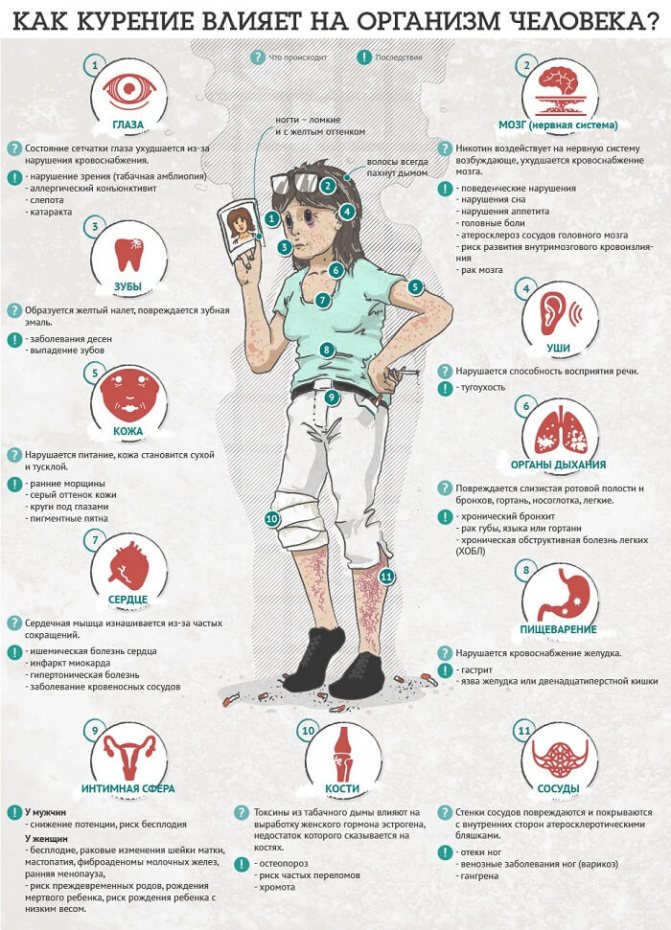
Signs of allergies appear equally in men and women. They affect the body differently, women are more sensitive to such substances and their body cleanses much more slowly. It is much more difficult for a woman to get rid of nicotine addiction than for a man.
This allergen is quite dangerous for children. Their reaction may be atypical; at first glance it may seem like a common cold.
Parents can begin to treat the child, but it will be unsuccessful. Symptoms of a sore throat may appear, the throat becomes red, and the cough is tormented.
Discharge from the nose appears, mucus of an uncharacteristic consistency is not as thick as with a cold; this is how allergies are distinguished from a cold.
↑
Be careful little children
Cigarette smoke is especially dangerous for young children. Chronic inhalation of tobacco components predisposes them to respiratory problems.
A red throat, sneezing, tearfulness, and frequent acute respiratory infections may indicate increased sensitivity to harmful components; in such conditions, parents unsuccessfully try to cure their child of colds.
It is quite simple to distinguish such ailments - all symptoms of a disease of allergic etiology disappear within a few days after the baby is in a smoke-free space.
How to treat allergies caused by smoking
Allergies caused by smoking require serious treatment and a responsible approach to it. It’s no secret that smoking is an addiction that needs to be gotten rid of urgently. Allergies can manifest themselves in different ways, and the sooner you start treating the first signs, the faster you will get rid of it.
The very first rule of allergy treatment, of course, is quitting smoking. In addition, such a patient is prescribed:
- antihistamines, which can be prescribed either as a course or as a single use;
- drugs that can relieve allergic manifestations such as cough, rash, and so on;
- means to strengthen the immune system;
- vitamin C, which is usually prescribed in a course of 2 months;
- decoctions of various herbs.
An allergy to tobacco smoke or to smoking itself is a very serious disease that can cause severe complications. At the first signs, you should immediately contact an allergist and follow all the recommendations prescribed by him.
allergiyu.ru
Symptoms
With a true allergy to tobacco smoke, symptoms of the disease develop immediately after inhalation. This may include a sore throat, sneezing, watery eyes, itching of exposed areas of the body, or a sudden attack of headache.
Sometimes, due to his professional activity, a person is forced to be in a room with smoking employees every day, which affects his health, the appearance of constant headaches and respiratory diseases.
The health problems that arise are simply attributed to decreased immunity and fatigue from work, without linking them with allergies.
The truth can be revealed during a vacation, when a person spends it in the fresh air; if there are manifestations of this disease, then in a changed environment, all symptoms of deterioration in well-being disappear.
Unfortunately, to understand this, it takes at least two to three weeks; it is during this time that the ENT organs of a passive smoker are cleared of tar.
Allergy to cigarettes: symptoms, causes, treatment and prevention
Allergies plague many people. Among the provoking factors are various allergens that are present everywhere in the environment: dust, pollen, animal dander, food and even medications. Similar symptoms may also appear after smoking. Can there be an allergy to cigarettes, and what to do if it appears?
Causes of allergies to cigarettes and smoke
Not everyone knows whether there is an allergy to cigarettes. When symptoms of a reaction occur, namely, cough, runny nose, watery eyes, a person attributes them to a common cold, not realizing that tobacco smoke can also cause such manifestations.
Over time, clinical signs of allergy to cigarette smoke and odor progress, causing severe complications requiring specific therapy. This applies to both active smokers and passive smokers who are only in the presence of a person abusing the bad habit.
Whether there is an allergy to cigarettes depends on the composition of them. The body can react differently to each component. Most cigarettes contain substances such as tar, nicotine, ketone, arsenic, etc. Provocateurs of an allergic reaction are microscopic particles rich in protein, which the body mistakes for a foreign substance.
In most cases, smokers have a specific reaction to nicotine. Tobacco smoke itself does not play any role, since it does not contain foreign proteins. Only some particles contained in smoke can act as provocateurs, increasing the risk of irritation in the respiratory tract and the development of asthma.
The situation worsens when the body’s protective function decreases, that is, when the immune system is suppressed. The environmental situation in which a person lives is no less important. In addition to developing an allergy to smoke, a smoker also inhales dirty air, which contributes to a more severe course of the process.
Modern cigarette manufacturers include special compounds in their products that improve taste and extend shelf life. Despite this, such substances pose a great danger to health.
Allergies in passive smokers
Whether there can be an allergy to cigarettes due to passive smoking also depends on the level of weakening of the immune system and the body’s sensitivity to the components.
Being near a smoker, a person inhales many harmful substances, and if this happens on an ongoing basis, in addition to the risk of developing allergies, additional health problems affecting the respiratory organs may arise.
Symptoms of an allergy to cigarettes with or without a capsule in a passive smoker depend on the size of the room in which he is located and the level of ventilation. Relevant studies have proven that the risk of developing pathologies with active and passive smoking is the same.
Signs
Allergies to menthol and other types of cigarettes manifest themselves in different ways. These may include respiratory tract symptoms and cutaneous clinical manifestations.
Respiratory disorders
According to reviews, an allergy to cigarettes looks like a common irritation of the mucous membranes of the respiratory system. Therefore, the clinical picture is often confused with manifestations of colds and sore throats.
The only sign by which one can suspect an allergy to cigarettes (with menthol and other additional components) is the occurrence of symptoms immediately after smoking:
- redness of the eyes;
- increased lacrimation;
- itching in the sinuses;
- cough;
- sneezing;
- burning and dryness in the mouth;
- swelling of the eyelids or lips;
- nasal congestion;
- wheezing in the throat and lungs;
- feeling of lack of air;
- shortness of breath.
In some cases, allergic conjunctivitis occurs, requiring additional treatment.
Dermatological signs
How does an allergic reaction of the body manifest itself on the part of the skin:
- redness of the skin;
- swelling;
- itching syndrome;
- burning;
- the formation of plaques, small rashes, crusts.
Symptoms of the pathology most often occur on the face, palms, elbows or knees. You can see this from the photo.
Allergy to electronic cigarettes
Electronic cigarettes are no exception to the development of allergic reactions. They do not contain tobacco smoke, but they cause no less harm. Electronic cigarettes contain glycerin, nicotine, and various chemical additives that cause specific reactions.
Allergies to glycerin and propylene glycol, present in button cigarettes, are rarely diagnosed. More often, pathology develops in response to exposure to aromatic additives.
Typical symptoms of an allergy to e-cigarettes include:
- heartburn;
- cough;
- dyspnea;
- headache.
Many manufacturers position such symptoms not as an allergy to e-liquid, but as a sign of tobacco cessation. In their opinion, there is a withdrawal syndrome - a group of symptoms that occur when a bad habit is completely abandoned.
Glycerin in electronic cigarettes is contained in a small volume, so it is impossible to be poisoned by it. If you cannot avoid an allergy to e-liquid, you should immediately consult a doctor.
Allergies in children
In children, cigarette allergies manifest themselves more aggressively than in adults.
Characteristic symptoms:
- severe swelling of the mucous membranes;
- coughing;
- intense headache;
- peeling of the skin.
It is prohibited to smoke in a room where there are children, especially newborns.
Consequences of smoking for allergies
On the forums you can find a lot of evidence that an allergy to cigarettes can be accompanied by negative consequences from internal organs and systems. A fatal outcome cannot be ruled out if there is a high sensitivity to tobacco components. Death may be due to angioedema or anaphylactic shock.
Quincke's edema
The condition is characterized by swelling of the upper respiratory tract and face. A burning sensation occurs in the irritated area.
Quincke's edema can be so severe that the risk of complete occlusion of the airways and, as a result, respiratory arrest increases.
Anaphylactic shock
Symptoms characteristic of the condition are loss of consciousness, a marked decrease in blood pressure, pale or blue discoloration of the skin, increased heart rate, and impaired respiratory function.
Anaphylactic shock is often fatal.
Hay fever
The complication is characterized by the following symptoms:
- severe runny nose;
- swelling of the mucous membranes of the nasal sinuses;
- increased lacrimation;
- swelling of the eyelids;
- sneezing;
- itching in the eyes.
In 20% of cases, bronchial asthma develops.
Inflammation of the sinuses
The inflammatory process in the sinuses is called rhinitis. Complications of an allergic reaction are characterized by itching in the sinuses, runny nose, and sneezing. Rhinitis often develops into inflammation of the maxillary sinuses.
Respiratory diseases
If you abuse a bad habit on an ongoing basis, the risk of developing chronic diseases, namely asthma and bronchitis, increases.
Diagnostics
Whether there may be an allergy to cigarettes, or whether the symptoms that arise are associated with another provoking factor, only a doctor can determine.
Patient examination and interview
First of all, the allergist asks the patient about the duration of symptoms, their nature and duration, and possible provoking factors. Next, the visible mucous membranes and skin are examined for the presence of edema, hyperemia, and rash.
Skin tests
There are no special skin tests that can help identify an allergy to cigarettes. For this reason, the final diagnosis is made based on the collected data from an oral interview and examination of the patient.
Laboratory research
Laboratory studies to detect reactions to tobacco have also not been developed. If, after eliminating smoking, the symptoms disappear, we can say that they are caused by a bad habit.
Treatment methods
How to treat a tobacco allergy depends on the severity of clinical manifestations and associated complications. In most cases, you can limit yourself to conservative therapy.
Elimination method
A typical example of elimination treatment is the complete elimination of a bad habit. If allergy symptoms are not observed 7-14 days after stopping smoking, no therapeutic action can be taken.
Medications
To eliminate the symptoms of an allergic reaction, antihistamines are prescribed.
These may be in the form of tablets for oral administration:
- Zyrtec (from 350 rub.);
- Loratadine (from 60 rub.);
- Zodak (from 170 rub.).
Zyrtec Loratadine Zodac
Preparations in the form of ointments are also used to treat the skin:
- Fenistil (from 360 rub.);
- Gistan (from 98 rub.);
- Hydrocortisone (from 30 rubles).
Fenistil Gistane Hydrocortisone
To increase the protective function of the body, immunomodulatory compounds and vitamin complexes are prescribed:
- Broncho-Munal (from 600 rub.);
- ginseng infusion (from 50 rub.);
- Solgar vitamin complex (from 1,300 );
- Doppelhertz Active (from 360 );
- Omega 3-6-9 (from 500 rub.).
Omega 3-6-9 Doppelhertz Active Vitamins Solgar Ginseng Tincture Broncho-Munal
Any remedy should only be prescribed by a doctor.
Traditional methods
You can supplement the basic treatment prescribed by your doctor with folk remedies. Decoctions and infusions of medicinal herbs are taken internally. This could be chamomile, thyme, yarrow, string, etc. Such compositions help eliminate the inflammatory reaction and facilitate the removal of mucus from the respiratory tract.
If there is no allergy to bee products, honey is included in the diet to increase the body’s protective function and speed up recovery. To suppress the activity of skin symptoms, take baths with a decoction or infusion of string, celandine.
Prevention
Today, every second person abuses tobacco smoking. This applies to both men and women. The only way to prevent an allergic reaction is to avoid bad habits. Otherwise, the destruction of the immune system and the development of negative consequences cannot be avoided.
If there is no will to quit smoking, it is recommended to at least reduce the frequency of cigarette use. If serious symptoms indicating complications occur, you should immediately visit a doctor for a comprehensive diagnosis.
We recommend watching a video about the dangers of smoke for others
Dermatologist of the highest category and author of the website dermgid.com. For more than 15 years I have been helping people suffering from skin diseases of various origins.
Source: https://dermgid.com/allergiya/allergiya-na-sigarety-simptomy.html
Diagnostics and therapy
A visit to an allergist will help you make the correct diagnosis. The doctor will prescribe special tests, the results of which will determine the etiology of the disease.

A reliable sign of the disease is an improvement in general well-being with a change of environment and in the absence of influence from passive smoking.
A smoker gradually frees himself from signs of allergies when he gives up the bad habit; chronic rhinitis and cough, headache and fatigue go away.
Diagnosis of allergies
Unless a person has an immediate allergy to smoking, diagnosis can be difficult. A person may associate poor health with other reasons, for example, believing that he has a cold or is simply overtired. The moment of truth can be the elimination of the allergen, for example, a person leaves the city. If there are no smokers there, his condition improves dramatically.
An allergist, immunologist or therapist will also help determine the allergen using special tests.
Main method of treatment
The only treatment for allergy to tobacco smoke is considered to be the absence of inhalation of nicotine components. It is necessary to minimize contact with people who smoke and not allow them to smoke in the apartment or office.
You should stay away from public places where people smoke. After smoking, it is necessary to ventilate the premises; air conditioners with special filters help remove harmful components.
What needs to be taken.
If symptoms of an allergy to tobacco smoke appear, you must take an antihistamine in tablets.
To relieve a mild reaction, taking a single dose will be sufficient; if your health has deteriorated significantly, then to get rid of all the symptoms you will need to take the entire course of antihistamines.
The resulting allergy also affects the appearance of toxic breakdown products, which in turn predisposes to a decrease in the functioning of the immune system, so allergists advise undergoing preventive treatment.
Treatment of allergies using traditional and alternative medicine methods
When primary symptoms appear, antihistamines are usually used. It is necessary to choose drugs of the latest generation , which are characterized by fewer side symptoms, quick effect and a longer period of action.
These drugs include Levocetirizine, Desloratadine, Fexofenadine, Hifenadine. They are completely devoid of cardiotoxic properties. The popular Suprastin and Loratadine are already drugs of the “last century”.
The most effective way to treat an allergy to tobacco smoke is to quit smoking and avoid visiting places where people smoke. And if getting rid of nicotine addiction is a completely solvable task, then avoiding contact with smoke in society is extremely difficult, although states are making attempts to limit smoking areas. At the same time, smoking prevention programs go hand in hand with unhindered access to the drug.
In the complex treatment of allergies, anti-inflammatory drugs may be prescribed, as well as the use of other pharmacological forms, depending on the symptoms. Complicated allergies are treated by highly specialized specialists .
How to get rid of nicotine addiction using biomagnets? Let's find out how anti-smoking magnets work, their advantages and disadvantages.
In addition to allergies to electronic cigarettes, other harm from their use is possible. Read about it in this article, reviews from doctors and smokers.
Why you can’t smoke during pregnancy - https://ialive.ru/privychki/kurenie/kurenie-vo-vremya-beremennosti.html.
Treatment with folk remedies
Instead of industrial anti-inflammatory and expectorant drugs, you can use infusions and decoctions of herbs (chamomile, linden, thyme, coltsfoot, rose hips). Any herbal mixture is prepared according to the following scheme: for a tablespoon of dry mixture - a glass of boiling water, 10 minutes in a hot bath, leave for 10-15 minutes without heat, strain, take 50 ml three times a day after meals. The course of herbal treatment is about 3 months.
A weakened immune system plays a major role in the occurrence of allergies. This means we strengthen it with beekeeping products, echinacea tincture.
Allergy to smoking is not a myth, but a harsh reality . It can be successfully cured only by completely stopping the use of nicotine in any form. Nicotine destroys not only the body, but also the immune system, which is the main regulator of our health. Every smoker should remember that from allergies to cancer is just a stone's throw away. Keep your hands free from cigarettes, free yourself from a deadly addiction.
ialive.ru
Course of therapy
The standard course of therapy for the manifestation of this disease consists of the following scheme:
- Taking enterosorbents - drugs aimed at neutralizing toxins and gently removing them from the body.
- Immune stimulation. Increasing the body's defenses can be achieved by taking immunomodulators, vitamin complexes, and general health improvement of the body through hardening and adherence to the principles of rational nutrition. It helps to increase the protective functions of the bronchopulmonary system by taking bee products - bee bread, pollen, honeycomb, propolis.
- Treatment of symptomatic manifestations. Rhinitis is treated with vasoconstrictor drops; for conjunctivitis, eye rinsing and instillation of antihistamine drops are indicated. Rash on the body is treated with external ointments with an anti-inflammatory effect.
For smokers, a course of expectorant herbs is recommended - coltsfoot, thyme, linden.
With their help, sputum containing tobacco components is removed; such measures do not allow some of the harmful substances to be absorbed into the organs.
Particular attention should be paid to the saturation of the body with vitamin C - it should be taken separately as dietary supplements.
Citrus fruits contain a lot of vitamin C, so smokers are advised to eat at least one orange a day.

But in order not to harm your health, read on the topic: Allergy to vitamin C.
People suffering from an allergy to tobacco smoke need to completely eliminate the influence of harmful substances nicotine, since once such a disease appears, it will haunt them for the rest of their lives.
Treatment
Initially, it is necessary to eliminate the allergen. As a rule, a tobacco allergy will go away in 2-3 weeks. This is how much the body needs to remove harmful substances. If complications arise, special means should be used.
Medications
They must be prescribed by a doctor:
- Antihistamines - Benadryl, Tylenol, Erius, Telfast, Claritin, etc. Drops are prescribed for infants - Zyrtec, Fenistil, Zodak.
- Antihistamine gel, cream or ointment that relieves itching - Lorinden, Gistan, Vundehil, Fenistil-gel, Soventol, Beloderm, etc...
- To make breathing easier - Pro-Air, Ventolin, etc...
- Medicines that relieve nasal congestion - Vibrocil, Novodrin, Histimet, Cromohexal, Cromosol, etc...
- Products that help remove toxins – Enterosgel, Polysorb, activated carbon tablets.

Traditional methods
Before using them, consult a specialist. Otherwise, you risk provoking an additional allergic reaction and worsening the condition:
- 1 tbsp. l. Brew 1 tbsp linden inflorescences. boiling water, leave for half an hour. Drink 4 tbsp. l. three times a day after meals.
- 1 tbsp. l. Mix crushed burdock and dandelion roots with 0.5 liters of boiling water, cook for 10 minutes, wait until it cools. Take ½ tbsp. before meals twice a day.
- Barley groats are poured with cold filtered water for 12 hours. You need to drink the infusion 3-4 tbsp. l. after eating for three weeks.
- For itching, baths with infusions of chamomile, string, and sage will help.
- Egg shells relieve allergic symptoms well. It needs to be washed and crushed into powder. Combine 1 tbsp. l. powder and 1 tsp. lemon juice and water. Take twice daily for a week.
- 1 tbsp. l. pour 150 ml of boiling water over calendula flowers and cool. Drink 1 tbsp. l. three times a day.
High-quality honey and bee products also help to cope with the consequences of smoking. Smokers are recommended to eat one orange every day.
About the dangers of smoking
We can talk about the dangers of smoking for a long time. But the most important thing to remember is that a bad habit affects not only the occurrence of serious problems with the respiratory and cardiovascular systems of the smoker himself, but also leads to health problems for others.
Laws are currently being introduced to prohibit smoking tobacco in public places. Such events make the lives of people suffering from allergies to tobacco smoke much easier and allow them to visit places where previously they could get an attack of an allergic reaction instead of relaxing.
Drugs
Pharmacies offer a wide range of anti-allergy medications. The fourth generation products are considered the most effective.
These include medications containing the following substances: Desloratadine, Fexofenadine and Levocetirizine. The names of these remedies are Cetrilev, Erius, Fexadin, Telfas and Eden.
Medicines against tobacco allergies are available in the following forms:
- Tablets;
- Drops in the nose and eyes;
- Drugs that are injected into a muscle or vein;
- Siropov.
If a patient has atopic bronchitis due to an allergic reaction, then he is prescribed medications that remove phlegm from the lungs:
- Bromhexine;
- Mukaltin;
- Bronholitin.
To reduce the number of coughing attacks, you need to use aerosols:
- Salbutamol;
- Fenoterol;
- Ventolin.
There is no need to prescribe medications yourself. Only the attending physician should calculate the dosage and select medications.
Definitely, smoking tobacco from the moment an allergic reaction is detected is strictly prohibited. Otherwise, if you take antihistamines during a relapse of the disease, the severity of the allergy will only worsen.
Types of smoke allergies
To tobacco
Tobacco smoke contains a lot of tar, carbon dioxide, some heavy components of chemical origin, carcinogens and other substances, each of which can cause a reaction.
They seriously impair the functioning of the immune system and increase the risk of developing other types of allergies.
To cigarette
It is the dependence on nicotine, a narcotic substance, that is the reason why it is so difficult for smokers to quit their bad habit.
This allergy can be compared to an allergy to the smell of perfume, cosmetics or a certain plant.
What harmful substances are contained in cigarettes?
To the smoke of a hookah
Although hookah is less harmful than cigarettes, its smoke contains many substances that can cause allergies. These can be the same resins or components of the tobacco mixture.
E-Sigs
They are popular among those who are thinking about saying goodbye to a bad habit. A common question is: can there be an allergy to such cigarettes?
The composition of electronic products includes propylene glycol, glycerin, various herbs, and aromatic additives. A reaction to any of these components is also possible. But since there are disproportionately fewer harmful substances, allergies to electronic cigarettes are less common.
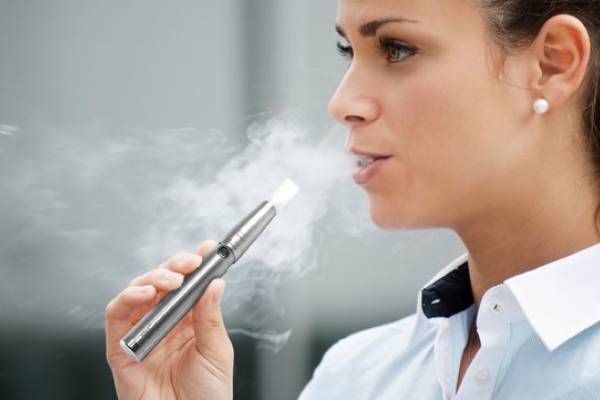
Symptoms of a smoke allergy
Almost always, signs of such an allergy make themselves felt through the respiratory system. The symptoms of the reaction are most acute in smokers.
In non-smokers, the symptoms are similar, but they will be somewhat weaker.
For non-smokers
Allergy symptoms are as follows:
- Respiratory disorders. There is constant sneezing, nasal congestion or mucus from the nose.
- Effect on the eyes. Usually occurs in passive smokers. Tobacco smoke can irritate the mucous membrane, cause lacrimation, and redness of the whites of the eyes.
- Effect on the respiratory organs. When inhaled, tobacco components affect the lungs, irritate them and cause swelling. The mucous membrane of the bronchi and throat also suffers.
In the first stages, coughing, shortness of breath and even suffocation may occur.
In children
For young children, smoke is most dangerous. Systematic inhalation of tobacco components can cause dangerous respiratory problems.
The symptom may be:
- Redness of the throat;
- Tearing;
- Sneeze;
- Constant occurrence of acute respiratory infections.
Parents may confuse an allergy with a cold and try to treat it unsuccessfully. But it's easy enough to tell the difference. Allergy symptoms disappear a couple of days after the baby completely stops contact with smoke.
In pregnant women
Tobacco smoke is a double danger for a pregnant woman.
Expectant mothers are prohibited not only from smoking, but also from being in rooms where someone else is doing so.
Their symptoms are similar to those of other adults, but the fetus is subject to serious harm, which can negatively affect the unborn child in the future.
At the smoker's
Symptoms:
- When inhaling cigarette smoke, a cough appears , which ends only when contact ends. The same goes for sneezing;
- resembling water may appear from the nose Nasal congestion is also evident, and breathing problems are possible;
- Rarely, an allergy may be accompanied by a rash and itching of the skin . The eyelids and areas around the mouth and nose are mainly affected;
- Swelling may occur . The most severe of them is swelling of the laryngeal mucosa, which makes breathing difficult;
- Manifestations of bronchial asthma are possible.
Features of allergies
The disease occurs due to the fact that the body becomes quite sensitive to various substances and allergens. Any aggressive substance that gets into the body or onto the skin can cause an allergic reaction in the body.
An allergy to a particular irritant can manifest itself constantly or one-time, it all depends on the characteristics, predisposition of a person to allergies and the quality of the protective function.
There are allergens that a person often comes into contact with and it is difficult for him to avoid, for example, cigarette smoke. There are seasonal allergies. Symptoms of the disease are caused by food.

Everyone knows that smoking is harmful to the health of both the smoker himself and everyone around him. This has no effect on the number of people with nicotine addiction. Doctors diagnose many serious pathologies that are associated with smoking.
Recently, another dangerous allergen was identified – cigarette smoke. Allergies occur in non-smokers; they will be victims of passive smoking.
Allergies are quite a serious problem, because being on the street, it is difficult to protect yourself from this allergen.
Scientists have been arguing on this topic for a long time; there is an opinion that the substances contained in cigarette smoke cannot provoke allergies. But scientists prove the opposite; they have proven that toxins have a bad effect on the body.
Over time, people develop reactions to previously harmless substances, such as pollen or foods. This occurs due to a violation of the barrier function of the body’s mucous membranes; harmful elements pass through them much more easily.
It is not news that cigarettes are made from a large number of harmful toxins that harm the body of the smoker and everyone around him. The substances have a bad effect on the environment and pollute the air.
Smoke molecules remain in the room for a long time and are poorly ventilated. And when an allergy sufferer enters such a room, symptoms immediately appear, even if they have been smoking there for a long time. This is a rather unpleasant feature of this disease.
The characteristics of the development and manifestation of allergies are no different from reactions to other substances. When smoke enters the body, the immune system reacts to it, to a foreign, harmful substance and begins to fight it. Antibodies are produced that provoke symptoms of the disease.
What to do if you are allergic to smoke
The first thing you should do is go to an allergist. Only he can make a correct diagnosis.
The specialist prescribes tests, based on the results of which it will be possible to talk about the nature of the disease.
A sign that you suffered from a smoke allergy is a complete elimination of symptoms and an improvement in well-being after the allergen disappears from your life.
If we are talking about a smoker, then by stopping smoking, he gets rid of cough, chronic rhinitis, constant weakness and pain in the head.
The following measures must be followed:
- Do not be in places and rooms where people smoke;
- If you quit smoking yourself, do a thorough cleaning of the apartment, thoroughly wash all surfaces, wash clothes and heat treat them;
- Certain indoor plants can help purify indoor air.
Symptoms of an insidious “cigarette” allergy
While scientists are understanding the mechanism of allergic reactions and finding out why one category of people is more susceptible to certain irritants and another to others, the pharmaceutical industry is actively engaged in the production of antihistamines. A trip to the pharmacy should be taken if symptoms such as:
- severe cough, sore throat,
- hoarseness of voice,
- difficulty breathing,
- dyspnea,
- nasal congestion,
- burning, eye irritation,
- itching and redness of the skin,
- swelling of the limbs, face.
Unfortunately, not only smokers, but also the people around them suffer from smoking allergies. Tobacco smoke penetrates their lungs, irritates the mucous membranes, settles on them and destroys the walls of blood vessels. The respiratory organs of active and passive smokers are weakened almost equally. How often do asthma, chronic runny nose, and dermatitis in non-smoking members occur in the family of a smoker? Such diseases are not completely cured until nicotine addiction is eliminated.
What kind of pills are used against smoking? Review of anti-smoking drugs, their principle of action, as well as the advantages and disadvantages of use.
Find out in this article what happens to the human body after quitting smoking. What improvements should we expect?
Tobacco smoke settles not only on the mucous membranes of everyone in the “access” zone, but also on the walls of the room. Smoking in an apartment or on the balcony of your own home, even with intensive constant ventilation, leaves smoke residues that continue their “dirty” work long after smoking has stopped in the room. A wife with bronchial asthma and a smoking husband is a fairly common combination; an allergic child and smoking parents are another manifestation of nicotine addiction.
If we were talking only about a slight runny nose or slight itching of the skin. Sometimes an allergy to smoking can result in life-threatening symptoms. Quincke's edema, anaphylactic shock - tobacco smoke can provoke these severe reactions. But a gradual increase in symptoms is the most common development option. A runny nose turns into sinusitis, a cough turns into bronchitis, difficulty breathing turns into bronchial asthma, itching and redness of the skin turns into psoriasis and allergic dermatitis.
Smoke allergy treatment
Allergy treatment methods are possible, both traditional and non-traditional.
The doctor gives recommendations only after analyzing the examination results.
Therapy is aimed at several measures:
- Taking antihistamines with an anti-inflammatory effect . They help to positively resolve the problem and improve immunity.
- For severe forms of allergies, anti-inflammatory medications are prescribed . They should only be used under the supervision of a specialist.
- Vitamin therapy . Constant use of vitamin C every day helps restore protective resources and strengthen the body.
- Decoctions of medicinal herbs such as chamomile, thyme, face, coltsfoot can be used.
Only a doctor has the right to prescribe drugs like Suprastin, Loratadine and others .
Clinical picture
Symptoms of an allergy to nicotine can appear both in smokers themselves and in people exposed to tobacco smoke. Manifestations of the disease can be varied, depending on the characteristics of each individual organism and the amount of the allergen exposed. Allergies can occur in both mild and severe forms, with symptoms that threaten the patient’s life.
View a selection of effective treatments for skin allergies in adults and children.
How does an allergy to drugs manifest itself in children and how to treat the pathology? Find out the answer from this article.
Mild symptoms of nicotine allergy may include:
- allergic rhinitis;
- nasal congestion;
- sneezing;
- conjunctivitis (tearing eyes, pain and burning, hyperemia);
- sore throat;
- allergic cough.
Systemic manifestations:
- headache;
- weakness;
- poor performance.
Less commonly, a reaction to nicotine manifests itself in the form of atopic dermatitis. It is characterized by:
- skin redness;
- severe skin itching;
- the formation of blisters with transparent exudate inside on the surface of the dermis.
In severe cases of allergies, the patient may experience:
- Quincke's edema;
- atopic or allergic bronchitis.
Atopic bronchitis is characterized by a severe cough that occurs when nicotine enters the lungs. This symptom can be chronic with periods of exacerbation and remission.
Angioedema is one of the most dangerous manifestations of allergies. It develops almost at lightning speed, accompanied by swelling of the pharynx and other tissues. The patient experiences shortness of breath and difficulty breathing.
On a note! If you suspect Quincke's edema, you should immediately call doctors at home; delay in providing first aid poses a threat to a person's life.
Analyzes
You need to see a doctor, at a minimum, so that he can determine what led to the negative symptoms - specifically smoke, or some other substance.
Diagnostics involves the following measures:
- History of the patient’s illness and life, specification of symptoms;
- Linked immunosorbent assay. Unable to show the clinical picture in full;
- Allergy tests on the skin, which at the initial stage work on the principle of excluding certain allergens.
There is no standard scheme for diagnosing a reaction to smoke. Everything happens in almost the same way as if another type of allergy is suspected.
About diagnostics
To confirm nicotine allergy or tobacco smoke, different diagnostic options are used. The fastest and most accessible methods are skin tests. Due to the large number of components that make up cigarettes, it is not always possible to identify the type of allergen, but these methods eliminate the possible effect of other irritants on the body.
During the diagnosis, one of the following procedures is performed:
- Application test. The liquid with the allergen is applied to the skin of the forearm. They wait a few minutes and assess the reaction on the skin.
- Scarification test. Treat the inside of the forearm with a liquid containing an allergen. Then they scratch the skin with a medical spear.
- Prick test. Once the solution is applied, the healthcare professional pricks the skin with thin needles. Each puncture is made no deeper than 1 mm.

Manipulations are carried out only at a time when there are no symptomatic manifestations of allergies.
No more than 15 samples are carried out at a time. Research results do not provide the basis for a final diagnosis.
About immunoglobulin blood test
The composition of the blood confirms the presence of an allergy, and also identifies the allergen. When the analysis is deciphered, the parameter of immunoglobulin protein E is assessed. It is present in the biological material in a minimal amount. If its parameters are increased, then this characterizes the presence of immunological processes. A detailed study will reveal which component the body reacts to with an allergy. With this study, the allergen can be determined during the period of exacerbation of the disease.
Allergies and smoking
It is known that such a bad habit as smoking can contribute to the manifestation of reactions to various allergens and intensify those that already exist. In addition, allergies can also develop to components of tobacco smoke. For example, many people notice that with an increase in the number of cigarettes smoked, not only a cough appears. If we delve further into this problem, we can discover the fact that smoking greatly weakens the body’s immune system.
Not everyone knows that allergies are not a harmless disease, as is commonly believed. And this is far from just an uncomfortable feeling. After all, even a slight allergy can cause an exacerbation of chronic diseases, and what is most unpleasant, cause new ones.
When you hear the word “allergy,” many people think of symptoms such as rash, itching and runny nose. However, very often there are such serious manifestations as Quincke's edema, asthma and various dermatitis. In addition, various autoimmune diseases may appear. And all this thanks to a bad habit.
So, to summarize, smoking significantly changes the reactivity of the human body, and not for the better.
Main symptoms
An allergy to cigarettes, in most cases, manifests itself in the same way as an ordinary allergy. This means that the body's immune system reacts to a foreign substance that it perceives as harmful. Accordingly, the symptoms of an allergy to cigarettes are very similar to the occurrence of a common infection. However, as is clear, in fact there is no infection in the body.
Note that manifestations can be either mild or severe. Dangerous symptoms include swelling of the larynx. Swellings may also occur in the mouth, head, or face. All of these will indicate a potentially fatal allergic reaction. In this case, you should immediately call an ambulance.
Mild symptoms of a cigarette allergy include:
- nasal congestion;
- smoker's cough;
- sore throat;
- allergic conjunctivitis (eyes watery, itchy, itchy);
- the appearance of shortness of breath;
- labored breathing.
It should be noted here that the body of each individual smoker will react differently to the irritating element.
I would like to warn you that in any case it is worth soberly assessing the situation. After all, any of the above symptoms may indicate not only an allergy, but also some developing viral disease. For example, a cough can develop into bronchitis or even pneumonia. This happens because smoking generally weakens the body's resistance. The immune system is weakened and it becomes harder to fight off the infection.
We conclude that any allergic manifestations should not be ignored, be they mild symptoms or dangerous ones.


